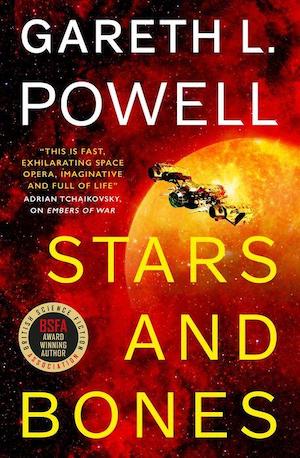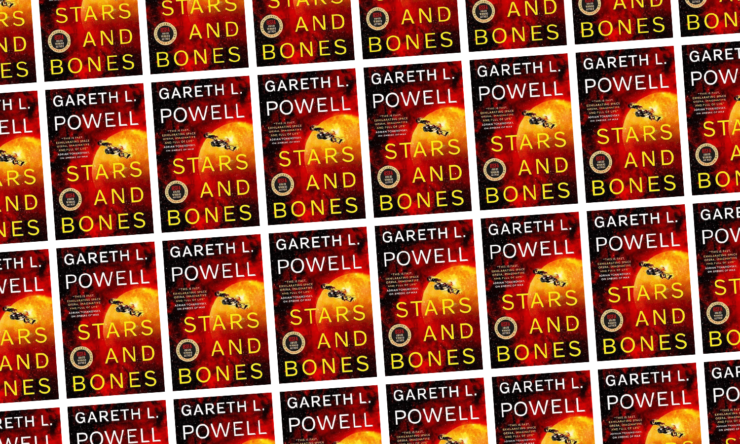A Deus Ex Machina is a person or thing (as in fiction or drama) that appears or is introduced suddenly and unexpectedly and provides a contrived solution to an apparently insoluble difficulty. In Gareth Powell’s Stars and Bones, the Deus Ex Machina is in the prologue and sets up the rest of the novel.
After an god like alien intervention stops what would be a civilization-ending nuclear war, the price of that intervention is humanity’s exile from Earth and any other such world. Humanity now lives on a series of great arks, comfortable and well-supplied, but on an eternal wandering among the stars. Man is still a curious species, sending scout ships to planets on the condition that they don’t try to land and settle. But on one planet, a Borg-like threat emerges that could wipe out or consume humanity entirely, and it may take yet another Deus Ex Machina from the “Angels” to solve the problem. As it so happens, the person best able to possibly contact the aliens who saved humanity the last time is in an undisclosed location. And the new threat is looking for him, too…
Where Powell’s previous series, Embers of War, was straight up far-future space opera, The Continuance is much more closely tied to our own place and time. Humanity has been saved at the cost of having its wings clipped, but they are only a couple of generations into their voyage. The main POV is Eryn, someone born on an ark, but Powell strikes a good balance changing between other POVs either in the past during humanity’s salvation, or a different view of the current situation.
The novel felt like a love letter to, or a riff on, many other novels of this type, but framed in Powell’s style and diction. There are elements and allusions to the work of Peter F Hamilton (with whom Powell has collaborated), Larry Niven, Tanya Huff, Alasdair Reynolds, Melinda Snodgrass, Adrian Tchaikovsky, Cordwainer Smith, Pixar’s Wall-E, Star Trek, Star Wars, and likely other influences and references that I missed entirely. This is a novel that was written with a love of space opera, and Powell puts his work squarely in dialogue and resonance with many of his fellow authors.
Buy the Book


Stars and Bones
There is a style, a feel to Powell’s work that is well represented here, and that is in the theater of character. While Powell may take worldbuilding inspiration from bits of other SF works, he turns the full powers of his invention to the characters he creates and their relationships. Stars and Bones has a wide and varied cast, but it is really at its heart the story of Eryn. Eryn has grown up in the fleet, has know the world of the migrating arks for all of her life. The fate of her sister, one of the people who disappeared in their encounter with Candidate 623, propels her into the plot and connects with the other characters who wind up standing against the threat (as it slowly becomes known, and as it slowly becomes an ever greater problem for humanity.
The real standout characters, besides Eryn, were the non-human ones. Readers of the Embers of War series knows that Powell likes to write AI characters, and this novel is no exception. The arks have physical avatars, humanoid (usually) interacting entities that members of a particular ark can communicate with. These avatars range from the scout ship Furious Ocelot all the way up to the huge ships like Great Barrier Reef. They have distinct and sometimes sharp personalities, and also can show the possibility of change and adaptation, especially once the enemy starts infiltrating and attacking the arks themselves. In particular, the bond between Eryn and the Furious Ocelot avatar is a strong and well developed relationship that is a real highlight of the novel.
Although they are literally a Deus ex Machina, I also found the Angels (as they are called) to be among the most interesting characters that Powell brings into relief. Raijin, the Angel that Eryn eventually seeks to meet in order to combat the threat from Candidate 623 is literally quite like a god in comparison to humanity, and the whys and hows of what he does is beyond the comprehension of the characters—yet Powell has a good hold on him as a character. It’s tricky to have superhuman characters as anything other than plot devices, but Powell manages it with Raijin.
There is also some lovely imagery here: the arks are rich and diverse, both on the outside as well as on the inside. From tropical parks, to giant oceanic spaces, to Mediterranean seacoast towns, to more traditional corridors and decks, the arks provide humanity with not quite the wide range of lost Earth, but enough that there is plenty to explore. It is even mentioned that some people have tried to “walk through” every ark but none have succeeded. There are also other rather striking images here, including a dive into a Black Hole, a megastructure and a fantastic chase scene through it, and much more. It’s a richly envisioned novel.
That goes to culture and sensibilities as well. Thanks to transport technology, the very technology that saved humanity, and the arks generally being close to each other, humanity has self selected and self sorted into communities and societies. With one notable exception, the ark communities are in effect post-scarcity economies and societies, and Powell shows a selection of communities with that sort of economics and base. He also rather pointedly makes fun of capitalism (as the main characters do find themselves at that aforementioned major exception) and the characters’ reactions at the absurdity of capitalism in a post-scarcity environment is delightful. Given that there was a ticking clock of a threat, we couldn’t get a tour of more ships, but I would love to see more of the arks. And, given that there are many arks only named, and many not even given that, I am sure that future novels in the series will have plenty of room to invent.
There is also a sense of found family here, but coming from it sideways as a theme. There is a sense that the old bonds of humanity have largely been excised, instead creating a whole raft of found families, arranging themselves in a way they never could on Earth. In a way, while posing new strictures, the angels have liberated humanity as well.
If this is your first Gareth Powell novel, you should know that he leavens his work with a lot of humor, especially of the dry British kind. This ranges from titles of chapters to quirks of characters. In Stars and Bones, all animals have been uplifted by the Angels, and so we wind up with a tabby cat named Sam as a secondary character who has opinions on the proceedings and provides some wry observations, especially about Eryn’s budding relationship with her inamorata, Li. (This is where I was thinking of Cordwainer Smith’s classic The Game of Rat and Dragon).
Although Stars and Bones is apparently the first novel set in this universe, it is a complete and whole story on its own. You can read this story, get a satisfying narrative from start to finish, get introduced to the setting and the verse and feel satisfied with that, and, at least in my case, be curious as to the questions raised about the verse and what else is out there in the Continuance universe. Powell’s experience in crafting a story really comes into play here, and I look forward to what happens to the fleet and its inhabitants in the next installment.
Stars and Bones is published by Titan Books.
An ex-pat New Yorker living in Minnesota, Paul Weimer has been reading sci-fi and fantasy for over 30 years. An avid and enthusiastic amateur photographer, blogger and podcaster, Paul primarily contributes to the Skiffy and Fanty Show as blogger and podcaster, and the SFF Audio podcast. If you’ve spent any time reading about SFF online, you’ve probably read one of his blog comments or tweets (he’s @PrinceJvstin).










